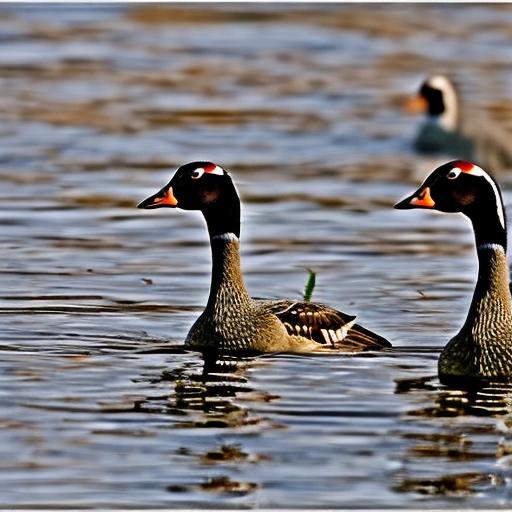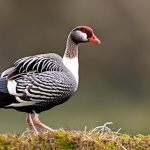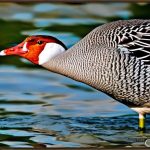Canadian geese are a common sight in many areas of North America, including near bodies of water such as lakes and ponds. While these majestic birds can be a delight to observe, they can also cause problems when they decide to make docks their home. The droppings left behind by geese can be unsightly and unsanitary, and their presence can deter people from using the dock for recreational activities. Finding humane solutions to this problem is important in order to protect both the dock and the geese themselves.
Key Takeaways
- Canadian geese are attracted to open water and grassy areas near water sources
- Physical barriers such as netting or fencing can prevent geese from landing on your dock
- Visual deterrents like scarecrows or reflective tape can startle geese and discourage them from landing
- Sound deterrents like loud noises or predator calls can also repel geese
- Taste deterrents like bitter sprays or repellent granules can make your dock unappealing to geese
Understanding the behavior of Canadian geese
In order to effectively address the issue of geese on docks, it is important to understand why they are attracted to these structures in the first place. Geese are social animals that prefer to gather in large groups, and docks provide an ideal location for them to do so. Docks offer a safe and elevated vantage point for geese to rest, groom, and keep an eye out for potential predators. Additionally, docks often provide easy access to food sources such as grassy areas or nearby vegetation.
Implementing physical barriers on your dock
One effective way to deter geese from landing on your dock is by installing physical barriers. Netting, fencing, and spikes are all options that can make it difficult for geese to access the dock. Netting can be installed around the perimeter of the dock to create a barrier that prevents geese from landing. Fencing can also be effective, especially if it is tall enough to discourage geese from attempting to fly over it. Spikes can be placed on flat surfaces of the dock to make it uncomfortable for geese to land.
When installing physical barriers, it is important to ensure that they are properly secured and maintained. Netting should be tightly stretched and securely fastened to prevent geese from getting tangled in it. Fencing should be sturdy and tall enough to deter geese from attempting to fly over it. Spikes should be regularly inspected and replaced if they become damaged or worn.
Using visual deterrents to scare off geese
Visual deterrents can also be effective in deterring geese from landing on your dock. Decoys, such as plastic owls or coyotes, can be placed on or near the dock to create the illusion of a predator. Flags or streamers can also be hung around the dock to create movement and scare geese away. These visual deterrents work by creating a sense of danger and making the dock appear less inviting to geese.
When using visual deterrents, it is important to regularly move them around to prevent geese from becoming accustomed to their presence. Geese are intelligent animals and can quickly learn that a decoy or flag poses no real threat if it remains in the same location for an extended period of time. By regularly moving visual deterrents, you can maintain their effectiveness in deterring geese.
Installing sound deterrents to repel geese
Sound deterrents can be another effective tool in repelling geese from your dock. Speakers or alarms that emit loud noises can startle geese and make them uncomfortable, causing them to seek out quieter areas. However, it is important to use sound deterrents responsibly and considerately, as loud noises can also disturb nearby residents or wildlife.
When using sound deterrents, it is important to follow local noise regulations and consider the impact on your neighbors. Set timers on the devices to only activate during daylight hours when geese are most active. Additionally, be mindful of other wildlife in the area that may be sensitive to loud noises, such as nesting birds or small mammals.
Applying taste deterrents to discourage geese from landing on your dock

Taste deterrents can be an effective way to discourage geese from landing on your dock by making the surface unappealing to them. Sprays or gels that contain bitter or spicy substances can be applied to the dock to deter geese from landing and encourage them to seek out more palatable areas. These taste deterrents are safe for both geese and the environment.
When applying taste deterrents, it is important to follow the manufacturer’s instructions and apply them evenly and thoroughly. Reapply the deterrents as needed, especially after rain or heavy use of the dock. It is also important to regularly inspect the dock for any signs of damage or wear to ensure that the taste deterrents remain effective.
Maintaining a clean dock to avoid attracting geese
Keeping your dock clean and free of food and debris is an important step in preventing geese from being attracted to it. Geese are opportunistic feeders and will be drawn to areas where they can easily find food. Regularly sweep or hose down the dock to remove any food scraps or other debris that may be present. Additionally, consider installing trash cans with secure lids near the dock to discourage people from leaving food waste behind.
Creating a designated goose-free zone on your property
Creating a designated area for geese on your property can help keep them away from your dock. This can be done by providing an alternative habitat that is more suitable for geese, such as a grassy area away from the dock. By providing a designated goose-free zone, you can encourage geese to gather in a location that is less disruptive and more compatible with their natural behavior.
When creating a goose-free zone, it is important to ensure that it meets the needs of geese and provides suitable habitat. This may include providing access to water, food sources, and shelter. It is also important to regularly monitor the area and make any necessary adjustments to ensure that it remains attractive to geese.
Seeking professional help for geese control
If you are struggling to effectively manage geese on your dock, it may be beneficial to seek professional help. Wildlife control professionals have the knowledge and experience to implement humane and effective strategies for geese management. They can assess your specific situation and recommend the most appropriate solutions for your dock.
When seeking professional help, it is important to choose a reputable and experienced wildlife control company. Look for companies that are licensed and insured, and ask for references from previous clients. Additionally, consider contacting local wildlife organizations or government agencies for recommendations.
Educating neighbors and community members on goose management
Educating neighbors and community members on humane goose management is an important step in addressing the issue of geese on docks. By sharing information and resources, you can help create a collective effort to find humane solutions that benefit both people and geese. Consider organizing community meetings or workshops to discuss the issue and share strategies for managing geese.
When sharing information with neighbors and community members, it is important to approach the topic with empathy and understanding. Some people may have concerns or misconceptions about geese that need to be addressed. Provide accurate information about geese behavior and the importance of finding humane solutions. Encourage open dialogue and collaboration to find solutions that work for everyone.
Respecting wildlife while protecting your dock from geese
While it is important to protect your dock from geese, it is equally important to respect wildlife and their natural behaviors. Geese are a valuable part of our ecosystem and play an important role in maintaining healthy wetland habitats. When implementing deterrents or management strategies, it is important to prioritize methods that are humane and do not cause harm to geese or other wildlife.
Finding a balance between protecting your dock and respecting wildlife can be challenging, but it is possible. By using humane deterrents, creating alternative habitats, and seeking professional help when needed, you can effectively manage geese while minimizing harm to them and their natural behaviors.
In conclusion, finding humane solutions to the problem of geese on docks is important in order to protect both the dock and the geese themselves. Understanding the behavior of geese and implementing physical barriers, visual deterrents, sound deterrents, taste deterrents, and maintaining a clean dock can all be effective strategies for managing geese. Creating a designated goose-free zone, seeking professional help, and educating neighbors and community members are also important steps in addressing the issue. By finding a balance between protecting your dock and respecting wildlife, you can effectively manage geese in a humane way.
If you’re looking for effective ways to keep Canadian geese off your dock, you might also be interested in learning about how to create a secure and predator-proof chicken coop. Poultry Wizard offers a helpful article on building a chicken coop in Muskegon, which provides valuable insights into constructing a coop that can keep your chickens safe from potential threats. Check out their article on chicken coop construction in Muskegon to discover practical tips and techniques that can be adapted to protect your dock from unwanted geese visitors.
FAQs
What are Canadian geese?
Canadian geese, also known as Canada geese, are large waterfowl native to North America. They are known for their distinctive black heads and necks, white patches on their faces, and brown bodies.
Why do Canadian geese congregate on docks?
Canadian geese are attracted to docks because they provide a safe and elevated vantage point for the geese to rest, groom, and keep an eye out for predators. Docks also often have easy access to water and nearby food sources.
Why is it important to keep Canadian geese off docks?
Having Canadian geese on docks can lead to several issues, including droppings that can create a mess and health hazards, damage to the dock from their sharp claws, and aggressive behavior towards humans or other animals.
How can I keep Canadian geese off my dock?
There are several methods to deter Canadian geese from congregating on your dock, including installing physical barriers like netting or fencing, using visual deterrents like scarecrows or reflective tape, employing noise deterrents like loud noises or predator calls, and applying taste deterrents to the dock surface.
Is it legal to harm Canadian geese to keep them off my dock?
Canadian geese are protected under the Migratory Bird Treaty Act, which makes it illegal to harm, harass, or kill them without a permit. It is important to use humane and non-lethal methods to deter Canadian geese from your dock.
Meet Walter, the feathered-friend fanatic of Florida! Nestled in the sunshine state, Walter struts through life with his feathered companions, clucking his way to happiness. With a coop that’s fancier than a five-star hotel, he’s the Don Juan of the chicken world. When he’s not teaching his hens to do the cha-cha, you’ll find him in a heated debate with his prized rooster, Sir Clucks-a-Lot. Walter’s poultry passion is no yolk; he’s the sunny-side-up guy you never knew you needed in your flock of friends!







